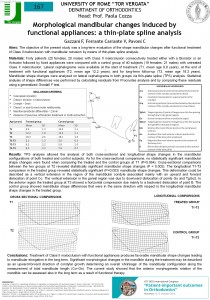OBIETTIVO: Obiettivo del presente studio è stato quello di valutare, nel lungo termine, le modifiche morfologiche mandibolari indotte dalla terapia funzionale, in pazienti con malocclusione di Classe II da retrusione mandibolare, attraverso analisi morfometrica.
MATERIALI: 40 pazienti (20 f, 20 m) in Classe II con retrusione mandibolare, sottoposti a terapia con Bionator o Attivatore e successivamente a terapia fissa, sono stati confrontati con un gruppo controllo di 40 soggetti (19 f, 21 m) con malocclusione di Classe II non trattata. Sono stati raccolti i telecrani in proiezione latero-laterale all’inizio del trattamento (T1, 9.9 anni), alla fine del trattamento (T2, 12.2 anni) e dopo osservazione a lungo termine (T3, 18.3 anni). Le modifiche morfologiche scheletriche sono state analizzate, in entrambi i gruppi, attraverso analisi morfometrica con thin-plate spline. Le differenze morfologiche sono state analizzate statisticamente attraverso il permutation test.
RISULTATI: In entrambi i gruppi si evidenziano, nel lungo termine, significative modifiche morfologiche longitudinali a livello della mandibola, caratterizzate da un dislocamento del punto Co in direzione postero superiore associato a un’estensione verticale della regione goniaca e a un riposizionamento inferiore del punto B.
CONCLUSIONI: Nel breve termine, la terapia funzionale induce una significativa post-rotazione morfogenetica mandibolare. Nel lungo termine, invece, entrambi i gruppi mostrano una forma mandibolare simile.
——————————–
Morphological mandibular changes induced by functional appliances: a thin-plate spline analysis
Aim: The objective of the present study was a long- term evaluation of the shape mandibular changes after functional treatment of Class II malocclusion with mandibular retrusion by means of thin-plate spline analysis.
Materials: Forty patients (20 females, 20 males) with Class II malocclusion consecutively treated with either a Bionator or an Activator followed by fixed appliances were compared with a control group of 40 subjects (19 females, 21 males) with untreated Class II malocclusion. Lateral cephalograms were collected at the start of treatment (T1, mean age 9.9 years), at the end of treatment with functional appliances (T2, mean age 12.2 years) and, after a long-term follow-up (T3, mean age 18.3 years). Mandibular shape changes were analyzed on lateral cephalograms in both groups via thin-plate spline (TPS) analysis. Shape differences were statistically analyzed by a permutation tests on Goodall F statistics.
Results: Both the treated and control groups showed significant longitudinal mandibular shape changes characterized by upward and forward dislocation of point Co associated with a vertical extension in the gonial region and backward dislocation of point B after a long term evaluation.
Conclusion: In the short term functional appliances induced a significant posterior morphogenetic rotation of the mandible. The treated and control groups demonstrated similar mandibular shape over the long term.

